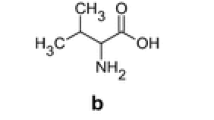Abstract
FOLLOWING Wu's experimental demonstration1 of Lee and Yang's predicted violation of the parity principle during β decay2 and following Goldhaber's demonstration3 of the circular polarisation of the bremsstrahlung produced by β-decay electrons, Vester and coworkers (ref. 4 and F. Vester, unpublished) proposed the following unique mechanism for the abiotic origin of optically active organic molecules  Attempts to demonstrate this mechanism experimentally4,5 were unsuccessful, however, until Garay's report in 1968 that D-tyrosine in dilute aqueous alkali was more decomposed (as evidenced by greater eradication of its ultraviolet absorption bands) than was L-tyrosine after 18 months exposure to 0.36 mCi of 90SrCl2 in solution6. One of us has attempted7 to repeat Garay's experiment using DL-tyrosine in alkaline solution, looking for optical rotation after exposing the sample to a dose of 4.1 × 108 rad of β-ray bremsstrahlung in a 61,7000-Ci 90Sr–90Y source at Oak Ridge National Laboratory for 1.34 yr. No optical activity was noted, using optical rotary dispersion (ORD) measurements in the region 250–630 nm. At the same time7 Garay's experiments were extended to include other racemic amino acids, both in the solid state and in neutral, acidic or alkaline solution. In no case, after the same 1.34-yr exposure, did we notice the development of optical activity either by ORD measurements or (in the case of DL-leucine) by the gas-chromatographic determination of the enantiomeric composition of the irradiated samples. Our explanation7 for these negative results has been that most of the bremsstrahlung causing radiolysis of the samples was of low energy8 and therefore of very slight circular polarisation3,9. In the hope of overcoming this difficulty, we have now undertaken similar experiments using longitudinally polarised electrons (and their bremsstrahlung) from a linear accelerator.
Attempts to demonstrate this mechanism experimentally4,5 were unsuccessful, however, until Garay's report in 1968 that D-tyrosine in dilute aqueous alkali was more decomposed (as evidenced by greater eradication of its ultraviolet absorption bands) than was L-tyrosine after 18 months exposure to 0.36 mCi of 90SrCl2 in solution6. One of us has attempted7 to repeat Garay's experiment using DL-tyrosine in alkaline solution, looking for optical rotation after exposing the sample to a dose of 4.1 × 108 rad of β-ray bremsstrahlung in a 61,7000-Ci 90Sr–90Y source at Oak Ridge National Laboratory for 1.34 yr. No optical activity was noted, using optical rotary dispersion (ORD) measurements in the region 250–630 nm. At the same time7 Garay's experiments were extended to include other racemic amino acids, both in the solid state and in neutral, acidic or alkaline solution. In no case, after the same 1.34-yr exposure, did we notice the development of optical activity either by ORD measurements or (in the case of DL-leucine) by the gas-chromatographic determination of the enantiomeric composition of the irradiated samples. Our explanation7 for these negative results has been that most of the bremsstrahlung causing radiolysis of the samples was of low energy8 and therefore of very slight circular polarisation3,9. In the hope of overcoming this difficulty, we have now undertaken similar experiments using longitudinally polarised electrons (and their bremsstrahlung) from a linear accelerator.
Similar content being viewed by others
References
Wu, C. S., Ambler, E., Hayward, R. W., Hoppes, D. D., and Hudson, R. P., Phys. Rev., 105, 1413 (1957).
Lee, T. D., and Yang, C. W., Phys. Rev., 104, 254–258 (1956).
Goldhaber, M., and Sunyar, A. W., Phys. Rev., 106, 826–828 (1957).
Vester, F., Ulbricht, T. L. V., and Krauch, H., Natunvissenschaft, 46, 68 (1959).
Ulbricht, T. L. V., and Vester, F., Tetrahedron, 18, 629–637 (1962).
Garay, A. S., Nature, 219, 338–340 (1968).
Bonner, W. A., J. molec. Evol., 4, 23–39 (1974).
Wyard, S. J., Nucleonics, 13, 44–45 (1955).
Schopper, H., Galster, S., Nucl. Phys., 6, 125–131 (1958).
Zeman, H. D., thesis, Stanford Univ. (1969).
Bonner, W. A., J. chromatogr. Sci., 11, 101–104 (1973).
Bonner, W. A., Van Dort, M. A., and Flores, J. J., Analyt. Chem., 46, 2104–2107 (1974).
Ulbricht, T. L. V., Q. Rev. Chem. Soc., 13, 48–60 (1959).
Gol'danskii, V. I., and Khrapov, V. V., Soviet Phys. JETP, 16, 582–585 (1963).
Author information
Authors and Affiliations
Rights and permissions
About this article
Cite this article
BONNER, W., DORT, M. & YEARIAN, M. Asymmetric degradation of DL-leucine with longitudinally polarised electrons. Nature 258, 419–421 (1975). https://doi.org/10.1038/258419a0
Received:
Accepted:
Issue Date:
DOI: https://doi.org/10.1038/258419a0
- Springer Nature Limited
This article is cited by
-
An inquiry into the selective protection of glycine during the radiolysis of glycine-alanine mixtures in aqueous solutions and its implications to the preservation of optically active amino acids in the early earth
Journal of Biological Physics (1996)
-
The origin and amplification of biomolecular chirality
Origins of life and evolution of the biosphere (1991)
-
Parity violation effects of weak interactions on the origin of biomolecular chirality
Il Nuovo Cimento D (1987)
-
Beta-gamma decay and stereoselective molecular breaking
Journal of Molecular Evolution (1987)





